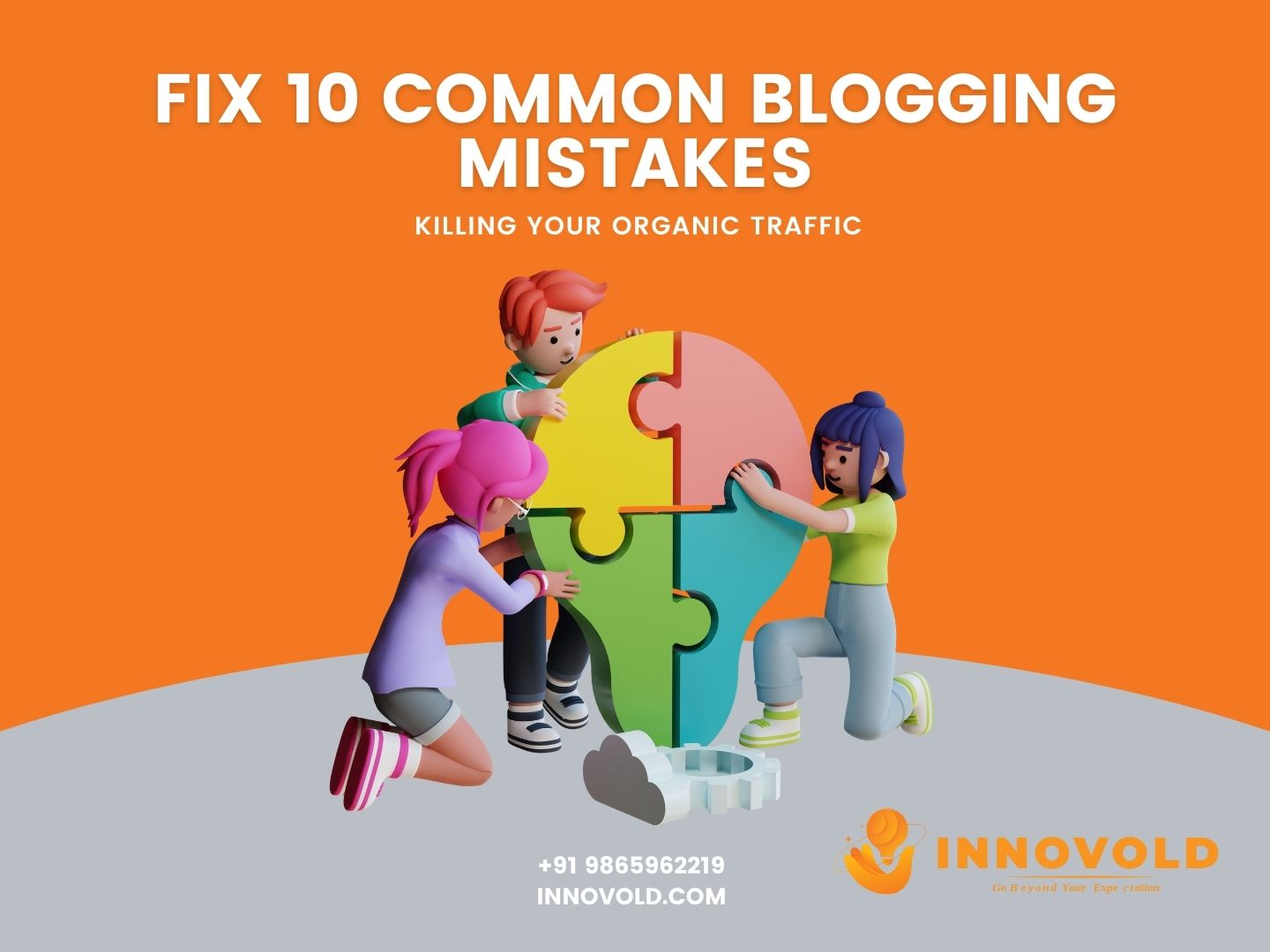Common Blogging Mistakes
In the digital age, organic traffic plays a pivotal role in the success of any blog. It’s not just about numbers; organic traffic represents engaged and interested users who can potentially become loyal followers or customers.
However, many bloggers inadvertently hinder their organic traffic growth due to common mistakes.
In this article, we’ll delve into these pitfalls and provide actionable insights to help you avoid them, ultimately boosting your blog’s visibility and success.
Table of Contents
Mistake 1: Neglecting Keyword Research
Effective SEO methods are built on a foundation of keyword research. By understanding the terms and phrases your target audience uses when searching for content, you can optimize your blog to rank higher in search engine results.
Neglecting this crucial step can severely limit your blog’s visibility. To conduct effective keyword research, utilize tools like Google Keyword Planner or SEMrush. Look for keywords with high search volume and low competition, and integrate them naturally into your content.
Mistake 2: Poorly Optimized Titles and Meta Descriptions
Compelling titles and meta descriptions are your blog’s first impression on search engine users. If they’re dull or irrelevant, users are less likely to click through to your content. Craft titles that are descriptive, engaging, and include relevant keywords.
Likewise, meta descriptions should accurately summarize your content and entice users to click. Avoid keyword stuffing and ensure both titles and meta descriptions are within the recommended character limits for optimal display in search results.
Mistake 3: Thin or Duplicate Content
Thin or duplicate content not only fails to provide value to your audience but also harms your SEO efforts. Search engines prioritize unique and informative content, so avoid duplicating content from other sources or within your blog.
Additionally, aim to create comprehensive and in-depth articles that thoroughly cover your chosen topics. Quality content not only attracts organic traffic but also encourages engagement and sharing.
Mistake 4: Ignoring On-Page SEO Elements
On-page SEO elements, such as headings, alt tags, and internal linking, are instrumental in signaling the relevance and structure of your content to search engines. Neglecting these elements can hinder your blog’s search visibility.
Ensure each page or post has a clear hierarchy with relevant headings and utilize descriptive alt tags for images to improve accessibility and SEO.
Furthermore, strategically incorporate internal links to enhance navigation and distribute link equity throughout your blog.
Mistake 5: Lack of Internal Linking
Internal linking not only facilitates navigation for users but also establishes a network of interconnected pages that search engines can crawl and index.
Failing to implement internal linking effectively can result in orphaned pages and missed opportunities for ranking. Include important internal links in your writing to direct readers to relevant resources or publications.
However, avoid excessive linking or linking to irrelevant pages, as this can disrupt the user experience and dilute your SEO efforts.
Mistake 6: Overlooking Mobile Optimization
With the majority of internet traffic originating from mobile devices, optimizing your blog for mobile users is non-negotiable. Neglecting mobile optimization can lead to a poor user experience and decreased search rankings.
Ensure your blog’s design is responsive and mobile-friendly, with fast load times and intuitive navigation. Test your blog across various devices and screen sizes to identify and address any usability issues promptly.
Mistake 7: Not Promoting Blog Posts
Producing excellent content is just half the fight; successful promotion is the other half. Without promotion, your blog posts may go unnoticed, severely limiting their organic reach.
Utilize social media platforms, email newsletters, and online communities to share your content with your target audience.
To increase your reach even more, get in touch with influencers and work together with other bloggers. Remember to tailor your promotion strategy to each platform and audience for maximum impact.
Mistake 8: Ignoring User Experience
User experience encompasses everything from site speed and navigation to content layout and readability. Poor user experience not only frustrates visitors but also impacts your search rankings.
Conduct regular usability tests to identify areas for improvement and optimize your blog accordingly. Focus on creating a seamless and enjoyable experience for users, ensuring they can easily find and consume your content.
Mistake 9: Neglecting Analytics and Tracking
Tracking and analyzing your blog’s performance is essential for identifying what works and what doesn’t. Failing to monitor analytics means missing out on valuable insights that could inform your content and SEO strategies.
Utilize tools like Google Analytics to track key metrics such as traffic sources, user demographics, and engagement metrics. Use this data to refine your content strategy, optimize for high-performing keywords, and improve overall user experience.
Mistake 10: Failing to Update and Maintain Content
Content freshness is a significant ranking factor for search engines. Neglecting to update and maintain your content can result in outdated information and diminished search visibility.
Regularly review and refresh your existing content to ensure it remains relevant and accurate. Update statistics, refresh outdated examples, and incorporate new insights or developments in your niche.
Additionally, monitor for broken links and technical issues that may arise over time, ensuring your blog remains user-friendly and search engine-friendly.
Conclusion
In conclusion, avoiding these common blogging mistakes is paramount for maximizing organic traffic and ensuring the long-term success of your blog.
By prioritizing keyword research, optimizing your content and technical elements, and focusing on user experience and promotion, you can position your blog for sustained growth and visibility in search engine results.
Remember, SEO is an ongoing process, so continually monitor and refine your strategies to adapt to changing algorithms and user behaviour. Here’s to your blog’s continued success!
GET IN TOUCH
Follow on Social Media
Bonus Tip 1: Invest in Long-Tail Keywords
While broad keywords may have high search volumes, they often come with intense competition. Long-tail keywords, on the other hand, are more specific phrases that typically have lower search volume but higher conversion rates.
By targeting long-tail keywords relevant to your niche, you can attract highly qualified traffic that is more likely to engage with your content and convert.
Use keyword research tools to identify long-tail opportunities and incorporate them strategically into your content to capture niche audiences effectively.
Bonus Tip 2: Leverage Rich Snippets and Structured Data
Rich snippets, such as featured snippets, knowledge graphs, and schema markup, enhance your content’s visibility and click-through rates in search engine results.
By implementing structured data markup on your blog, you can provide search engines with additional context about your content, making it more attractive and informative to users.
Explore the various types of rich snippets applicable to your content and optimize your markup accordingly to stand out in search results and drive organic traffic to your blog.
Bonus Tip 3: Optimize for Voice Search
With the rise of voice-activated assistants like Siri, Alexa, and Google Assistant, optimizing your content for voice search is becoming increasingly important.
Voice search queries tend to be more conversational and question-based, so focus on creating content that addresses common questions and specific user intents.
Optimize your content for featured snippets and incorporate natural language and long-tail keywords to align with voice search patterns.
By adapting your SEO strategy to accommodate voice search, you can stay ahead of the curve and capture valuable organic traffic from voice-enabled devices.



